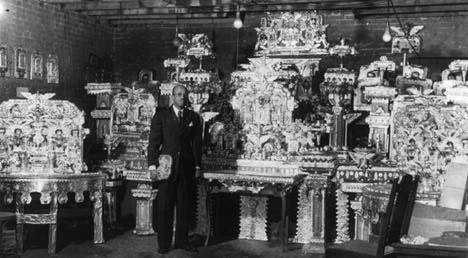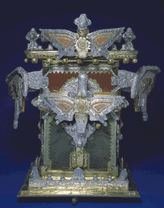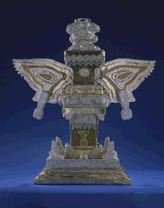| [Home][Gipper][Early][No.5][No.6][No.7][No.8][No.9][No.10] |

This photo was found after Hampton's death. The photographer's
identity has never been discovered.
The Miracle of St. James Hampton
by Mike Walsh
| [Home][Gipper][Early][No.5][No.6][No.7][No.8][No.9][No.10] |

This photo was found after Hampton's death. The photographer's
identity has never been discovered.
by Mike Walsh
| Visit these other missionCREEP sites |
| Bonnie Lasses, Tina Newberry's paintings of topless women |
| Slackjaw Online, Columns by the popular and grumpy NY Press columnist |
| Art on a Stick, Drawings and comics by B. Amundson |
| Mouth Wash, Stories, humor, and articles by Mike Walsh |
| Parables in Glass, Disturbing stained glass artwork by Judith Schaechter |
| missionCREEP's Recommended Movie List |
| Creative Non-Fiction, Autobiographical paintings by Sarah McEneaney |
| Strangely beautiful paintings by Mitch Gillette |
| Incredible wood carvings by Susan Hagen |
| Prodigies, James G. Mundie's drawings of sideshow performers of the past |
| Order, Chaos, and Dreams: The Art of Carol S. Nowak |
| 14 Stations: Carvings by Susan Hagen and stories by Mike Walsh |
From some time near the end of World War II until his death in 1964, James Hampton, a janitor for the General Services Administration in Washington, D.C., spent virtually every spare minute constructing a strange and beautiful masterpiece entitled, "The Throne of the Third Heaven of the Nations' Millennium General Assembly." The Throne, composed of 177 separate objects, each meticulously wrapped in silver and gold foil, is now on permanent display at the Smithsonian Institute's National Museum of American Art in Washington.
Hampton built his masterpiece from a very select collection of junk, including old furniture, burned-out light bulbs, jelly jars, carpet cylinders, desk blotters, cardboard, and foil. All the separate pieces are precariously held together with glue, tape, tacks, and pins.
The Throne's many pieces are arranged symmetrically on either side of a main throne chair. Matched pairs of smaller tables and ornaments decorate each side, the objects on the left referring to the New Testament, and, to the right, the Old Testament. The throne chair is crowned with the words "Fear Not," and tacked to a board is the inscription, "Where There Is No Vision the People Perish." Many of the pieces are tagged, and on the tags Hampton often refers to himself as "Saint James."
During the last fourteen years of his life, Hampton rented a small, unheated garage in a rundown section of D.C. to construct and house the Throne. He told very few people, if any at all, about his work, and he never opened the garage door or invited anyone inside. In fact, it was not until just after Hampton's death that the owner of the building learned of Hampton's Throne. It was through the landlord and an anonymous donor that the National Museum of American Art came to possess it. Before its permanent installation in the Smithsonian, the Throne was displayed in art museums in Minneapolis, New York, Boston, Virginia, and Alabama.
It is thought that Hampton hoped to one day become a preacher and open a small, streetside ministry with the Throne as the altar and central teaching device. He even conducted solitary services in the garage on Sundays. But his central motivation for building the Throne was as a tribute to his God. He believed, quite literally, in the Second Coming, and his work on the Throne was in preparation for that event. He also claimed to have communed regularly with the Almighty during the Throne's construction.

The Throne "may well be the finest work of visionary religious
art produced by an American." -- Robert Hughes
Fear Not
|
Very little is known of Hampton's life, even though he was in the Army and worked most of his adult life for the government. He was born in South Carolina in 1909. His father was an itinerant Baptist minister and gospel singer. Before his 20th birthday, Hampton moved to Washington and worked a few years as a short order cook. After serving in the Army during World War II, Hampton returned to Washington and spent the rest of his life laboring as both a janitor and throne builder. He died of cancer in a VA hospital in Washington in 1964. He never married and had no close friends.
Hampton's masterpiece was inspired by visions that persisted throughout his life. He recorded many of the visions on tablets that adorn the Throne. The first recorded vision took place when he was only 22-years-old: "This is true that the great Moses the giver of the tenth commandment appeared in Washington, D.C. April 11, 1931." Another reads, "This is true that Adam the first man God created appeared in Person on January 20, 1949. This was on the day of President Truman's inauguration." My favorite states that "...on October 2, 1946, the great Virgin Mary and the Star of Bethlehem appeared over the nation's capitol."
Hampton also filled several notebooks with writings he kept in conjunction with his work on the Throne. His wrote in a secret script of his own devising which, despite the efforts of cryptographers, has yet to be deciphered.
The real power of The Throne is understood only by actually going to see it. It is simultaneously enchanting, frightening, and awe-inspiring. The entire installation glows, like a halo, the spirit of Saint James pervading the room. It's also a little scary to look at the Throne and consider the strange circumstances of Hampton's life, marked as it was by loneliness, poverty, and obscurity.

But these circumstances clearly were not important to Hampton. No evidence has surfaced to suggest that he ever despaired or even questioned the value of his work. He simply forged on until he died, apparently undeterred by the complete lack of recognition for his work. Certainly Hampton would never have dreamed of the admiration his work now receives, but unfortunately, that recognition did not come until a decade after his death. It's worth noting that recognition of the Throne ultimately came from the artistic community, not the religious community.
Hampton's sense of dedication and faith can only be attributed to someone who has transcended the nagging concerns of a normal human existence. This man was a visionary, to whom creativity and unfailing dedication became the salvation not only for himself, but for all men.
Who has the strength of such conviction and faith? A lunatic? Probably not. The Throne contains too much order and structure. A saint? Perhaps. Saint James? Saint James the Throne Builder. Saint James of the Visions. Saint James of the Nations General Assembly.
"Where there is no Vision, the People Perish."
![]()
Other articles by Mike Walsh.
[TiltHome] [GipperIssue] [EarlyMadness] [No.5]
[No.6] [No.7]
[No.8] [No.9]
[No.10]
[PenisPage] [PeoplePage] [FeaturedWriters] [StoryCollection] [ExpressoPoems] [TheFunnies]
[missionCREEP]